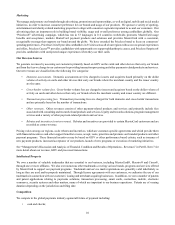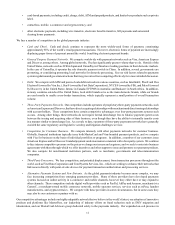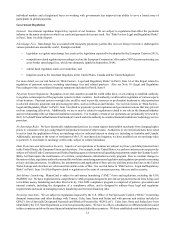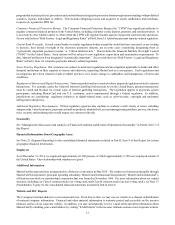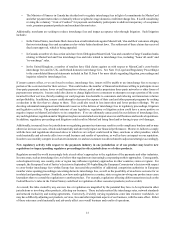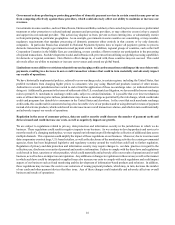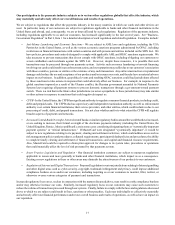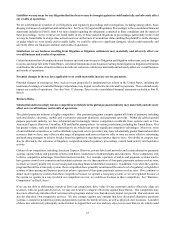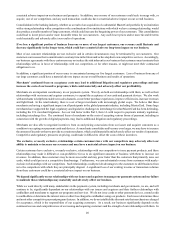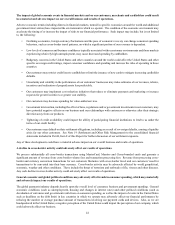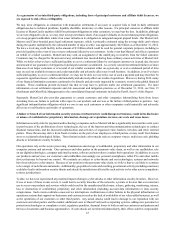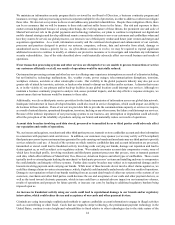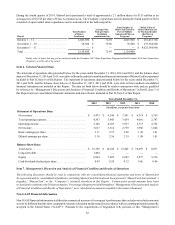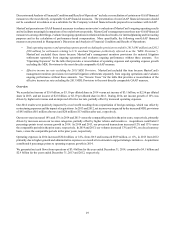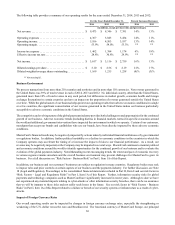MasterCard 2014 Annual Report Download - page 22
Download and view the complete annual report
Please find page 22 of the 2014 MasterCard annual report below. You can navigate through the pages in the report by either clicking on the pages listed below, or by using the keyword search tool below to find specific information within the annual report.20
a material adverse impact on our business and prospects. In addition, one or more of our customers could seek to merge with, or
acquire, one of our competitors, and any such transaction could also have a material adverse impact on our overall business.
Consolidation in the banking industry, whether as a result of an acquisition of a substantial MasterCard portfolio by an institution
with a strong relationship with a competitor or the combination of two institutions with which we have a strong relationship, would
also produce a smaller number of large customers, which could increase the bargaining power of our customers. This consolidation
could lead to lower prices and/or more favorable terms for our customers. Any such lower prices and/or more favorable terms
could materially and adversely affect our results of operations.
If we lose a significant portion of business from one or more of our largest customers, our revenue could fluctuate and
decrease significantly in the longer term, which could have a material adverse long-term impact on our business.
Most of our customer relationships are not exclusive and in certain circumstances may be terminated by our customers. Our
customers can reassess their commitments to us at any time in the future and/or develop their own competitive services. Accordingly,
our business agreements with these customers may not reduce the risk inherent in our business that customers may terminate their
relationships with us in favor of relationships with our competitors, or for other reasons, or might not meet their contractual
obligations to us.
In addition, a significant portion of our revenue is concentrated among our five largest customers. Loss of business from any of
our large customers could have a material adverse impact on our overall business and results of operations.
Merchants’ continued focus on acceptance costs may lead to additional litigation and regulatory proceedings and may
increase the costs of our incentive programs, which could materially and adversely affect our profitability.
Merchants are an important constituency in our payments system. We rely on both our relationships with them, as well as their
relationships with our issuer and acquirer customers, to expand the acceptance of our cards and payment devices. We also work
with merchants to help them enable new sales channels, create better purchase experiences, improve efficiencies, increase revenues
and fight fraud. In the retail industry, there is a set of larger merchants with increasingly global scope. We believe that these
merchants are having a significant impact on all participants in the global payments industry, including MasterCard. Some large
merchants have supported the legal, regulatory and legislative challenges to interchange fees that MasterCard has been defending,
including the U.S. merchant litigations. See our risk factor in this Part I, Item 1A with respect to payments industry regulation,
including interchange fees. The continued focus of merchants on the costs of accepting various forms of payment, including in
connection with the growth of digital payments, may lead to additional litigation and regulatory proceedings.
Merchants are also able to negotiate incentives from us and pricing concessions from our issuer and acquirer customers as a
condition to accepting our payment cards and devices. As merchants consolidate and become even larger, we may have to increase
the amount of incentives that we provide to certain merchants, which could materially and adversely affect our results of operations.
Competitive and regulatory pressures on pricing could make it difficult to offset the costs of these incentives.
The exclusive, or nearly exclusive, relationships certain customers have with our competitors may adversely affect our
ability to maintain or increase our revenues and may have a material adverse impact on our business.
Certain customers have exclusive, or nearly-exclusive, relationships with our competitors to issue payment products, and these
relationships may make it difficult or cost-prohibitive for us to do significant amounts of business with them to increase our
revenues. In addition, these customers may be more successful and may grow faster than the customers that primarily issue our
cards, which could put us at a competitive disadvantage. Furthermore, we earn substantial revenue from customers with nearly-
exclusive relationships with our competitors. Such relationships could provide advantages to the customers to shift business from
us to the competitors with which they are principally aligned. A significant loss of our existing revenue or transaction volumes
from these customers could have a material adverse impact on our business.
We depend significantly on our relationships with our issuers and acquirers to manage our payments system and our failure
to maintain those relationships may materially and adversely affect our business.
While we work directly with many stakeholders in the payments system, including merchants and governments, we are, and will
continue to be, significantly dependent on our relationships with our issuers and acquirers and their further relationships with
cardholders and merchants to support our programs and services. We do not issue cards or other payment devices, extend credit
to cardholders or determine the interest rates or other fees charged to cardholders using our products. Each issuer determines these
and most other competitive payment program features. In addition, we do not establish the discount rate that merchants are charged
for acceptance, which is the responsibility of our acquiring customers. As a result, our business significantly depends on the
continued success and competitiveness of our issuing and acquiring customers and the strength of our relationships with them. In


